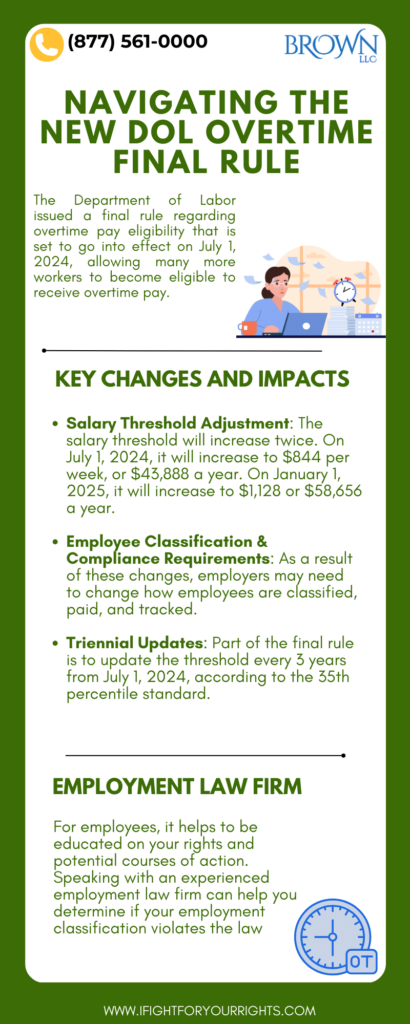Navigating the New DOL Overtime Final Rule: What You Need to Know

On April 23, 2024 the Department of Labor issued a final rule regarding overtime pay eligibility that is set to go into effect on July 1, 2024, allowing many more workers to become eligible to receive overtime pay. The rule is projected to benefit 4.3 million workers and transfer $1.5 billion a year in pay to hard-working American workers.[1] The minimum salary to qualify for an exemption of $35,568 will be increased via steps to $58,656 a year.
How the Current Overtime Law Works
The Federal Fair Labor Standards Act (FLSA) has overtime pay protections that ensure workers are paid 1.5 times their regular rate for hours worked over 40 per week provided they are not exempt from overtime pay. The Department of Labor uses a three-part test to check if executive, administrative, professional, and outside sales employees qualify for an exemption and are therefore ineligible for overtime pay. For an employer to qualify for these exemptions the worker must be salaried, earn over a certain threshold a year, and have certain duties or responsibilities as a part of their role. In other words, certain roles–like managers or credentialed professionals–may be ineligible for overtime pay.[2]
Currently, the overtime salary threshold is set at $684 a week, equivalent to $35,568 a year. Salaried employees paid at this rate could work 60-70 hours a week and receive the same amount of wages as if they had only worked 40 hours, provided that the constructive hourly rate is above minimum wage. This salary minimum was established under former President George W. Bush’s administration, almost 15 years ago. The current threshold was based on the 20th percentile of weekly earnings of full-time salaried workers in the lowest wage region of the country and has not been updated since 2019 to reflect increases in wages and prices as a natural result of inflation. According to the Economic Policy Institute, this current threshold is “inappropriately weak.” [3]
Key Changes and Impacts of The Department of Labor’s Final Rule
As a result of the new requirements, employees will now have more security when working long hours, and employers will be required to pay them higher wages–whether it be through overtime pay or higher salaries. The new final rule does not change any other parts of the three-part test, so as long as an employee’s job duties do not change and their salary remains above the threshold, they would be unaffected by this rule. Below are the key takeaways from the final rule:[4]
- Salary Threshold Adjustment: Over the next 8 months, the salary threshold will increase twice. On July 1, 2024, it will increase to $844 per week, or $43,888 a year. On January 1, 2025, it will increase to $1,128 or $58,656 a year. These amounts are based on the 35th percentile of weekly wages for full-time, salaried workers in the lowest-wage Census region.
- Employee Classification & Compliance Requirements: As a result of these changes, employers must reevaluate their internal policies. In order to comply with these new rules, they may need to change how employees are classified, paid, and tracked. Should they fail to adequately do so, they may face legal action that would result in penalties and back pay to their employees.
- Triennial Updates: Part of the final rule is to update the threshold every 3 years from July 1, 2024, according to the 35th percentile standard mentioned above. These automatic updates are intended to protect employee rights while providing a regular interval for businesses to anticipate the increase in wage requirements.
Speak with the Lawyers at Brown, LLC Today!
Over 100 million in judgments and settlements trials in state and federal courts. We fight for maximum damage and results.
Pushback Against the Final Rule
While certain organizations like the Economic Policy Institute emphatically support the passage of this new final rule, not everyone is on board. In 2016, under the Obama administration, the government attempted to set the threshold at the 40th percentile of the lowest wage region. However, the rule never went into effect as the Eastern District of Texas ruled that the salary threshold was so high that it “effectively eliminated” the duties portion of the three-part test. Furthermore, they also ruled that the automatic update went beyond the Department of Labor’s authority.[5]
The final rule set to go into effect on July 1, 2024 is materially very similar to the Obama-era rule that was shot down, aside from a marginally lower threshold. The current rule is likely to face similar pushback; the president of public affairs for the National Restaurant Association says that “the rule will ‘exponentially increase’ operating costs for small restaurant owners who are ‘trying desperately’ to keep menu prices steady.” [6]
Similarly, the vice president of regulatory, labor, and state affairs at Associate Builders and Contractors says it will “greatly restrict employee workplace flexibility in setting schedules and hours, hurting career advancement opportunities.”[7] Many other businesses and associations have voiced concerns over the final rule, but as of April 25, 2024, there has yet to be an injunctive court ruling that could stop the rule from going into effect.
How to Navigate the Final Rule
As a business owner, addressing the final rule will mean rearranging finances and reevaluating employee classifications to ensure that they are being paid correctly.
For employees, it helps to be educated on your rights and potential courses of action, so that if your employer is violating this rule, you can be compensated properly under such laws as the Fair Labor Standards Act (FLSA). Speaking with an experienced employment law firm can help you verify if your employment classification violates federal regulations and/or state regulations. An overtime attorney can significantly help with organizing documents, filing a case, and ensuring that you get the wages you deserve from your employer if you’re underpaid. Best of all, some wage and hour lawyers, like the law firm of Brown, LLC are only paid if they win your case. So if you suspect you’re being cheated out of wages speak with an employment law firm like Brown, LLC who offers free consultations.
[1] https://www.dol.gov/sites/dolgov/files/WHD/flsa/ot-541-final-rule.pdf
[2] https://www.dol.gov/agencies/whd/compliance-assistance/handy-reference-guide-flsa
[3] https://www.epi.org/press/epi-president-heidi-shierholz-welcomes-department-of-labor-final-rule-to-raise-overtime-threshold/
[4] https://www.epi.org/blog/explaining-the-department-of-labors-new-overtime-rule-that-will-benefit-4-3-million-workers/
[5] https://news.bloomberglaw.com/daily-labor-report/millions-of-new-workers-eligible-for-overtime-under-dol-rule
[6] https://www.facilitiesdive.com/news/organizations-push-back-on-proposed-overtime-rule-change-dol/699567/
[7] https://www.facilitiesdive.com/news/organizations-push-back-on-proposed-overtime-rule-change-dol/699567/

